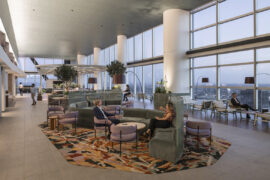While the Mid-Century Modernism of 1960s design has since given way to Neomodern and other new trends, some classics never die.
February 16th, 2018
The middle of the 20th century was a changing era for architecture, design, and style. And for 1960s office and interior design, this was an exciting time. From the lavish, Mad Men-styled offices of the wealthy to the modernist design the general public could now enjoy, the 1960s have a lot to love. Even beyond a nostalgic adoration, some 1960s design ideas and trends are still popular and worth considering today – with this in mind, here’s our take on five things from the era that are still brilliant today…
The beauty of the mid-century-modern design pieces from the 1960s is their versatility – you can treat them as feature pieces or liberally use them throughout any contemporary space. Modern style allows for aesthetic mixing, compared to the classic ‘wall to wall, floor to ceiling’ approach towards style of the early 20th and even late 20th century. The beauty of 60s office design is that, today, the clean lines and minimalism of the products and furniture from the era can stand alone, or be paired with feature pieces and artwork to serve as a canvas space for expression.
Following the 1950’s design trend of soft pastels and aesthetics intended to evoke a wholesome suburban comfort; the design trends of the 1960’s were far bolder and expressive. Set against a rapidly changing and more expression ready political and social setting, colour pallets soon exploded into bright oranges, yellows, blues, greens and reds. The colour pallette for 1960s design is all about expression, passion and action. Bold colours or accenting furnitures piece could serve as the design statement your office needs.
Beloved and classic for a reason, the Eames Lounge Chair and Ottoman are icons of mid century modernist design. Inspired by the traditional English Club Chair, the Lounge and Ottoman were the Eames’ first foray into high end furniture design. First designed in the decade prior, it was 1960s design trends that helped propel this pair into iconic status. From their house designs to their films and the legendary list of furniture work, husband and wife designers Charles and Ray Eames will surely go down as two of the all time greats in design – but it is perhaps this chair and ottoman combo, recalling “the warm, receptive look of a well-used first baseman’s mitt” as Charles put it, that will always be most linked with their name.


From flat pack furniture to iconic S and pod-shaped chairs made of space age materials, 1960s design saw furniture designers really stretching their creative arms. Metal, glass, wood and PVC were now all fair game when creating ranges to suit any number of styles, and this is something we still see today. Open shelving in the Danish style was now being embraced all over the world, often now used as break room separators. And individuals were properly leaning into styles that reflected their own tastes, rather than generic 50s ‘one size fits all’ approaches.


In the 1960s, technology was exploding alongside design and culture. With the space race in full swing, culminating in the moon landing in 1969, technology not only inspired design aesthetics, but also enabled greater explorations of possibilities for home design. From the popularity of lucite and newly coloured plastics being used for furniture and accessories, to tupperware’s explosion in popularity in suburbia, advanced technology was the name of the design game. For today, this means embracing the technological advances we’re currently experiencing, as well as seeing a place for the retro tech of past generations. The old school aesthetic of kitchen appliances offer a timeless charm for a break room, and paired with contemporary sleek technology can help serve a bridge between an appreciation of the 1960s design trends, and the necessity for use to grow and evolve with design.
Want more design inspiration? Sign up for our mailing list.
INDESIGN is on instagram
Follow @indesignlive
A searchable and comprehensive guide for specifying leading products and their suppliers
Keep up to date with the latest and greatest from our industry BFF's!

For those who appreciate form as much as function, Gaggenau’s latest induction innovation delivers sculpted precision and effortless flexibility, disappearing seamlessly into the surface when not in use.

In an industry where design intent is often diluted by value management and procurement pressures, Klaro Industrial Design positions manufacturing as a creative ally – allowing commercial interior designers to deliver unique pieces aligned to the project’s original vision.

Striking in its playful simplicity, eye-catching and charmingly self-assured – the renowned sofa system named after a chewing gum is making a comeback. And it’s more relevant than ever.
The internet never sleeps! Here's the stuff you might have missed

Unveiled at Barangaroo South, Indonesian–Australian artist Jumaadi’s first permanent public artwork layers sculpture, sound and shadow to reimagine how art is encountered in the city.

Designed by Woods Bagot, the new fit-out of a major resources company transforms 40,000-square-metres across 19 levels into interconnected villages that celebrate Western Australia’s diverse terrain.